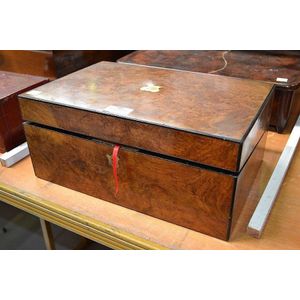English Mahogany Step Commode with Leather Inset Steps
You must be a subscriber, and be logged in to view price and dealer details.
Subscribe Now to view actual auction price for this item
When you subscribe, you have the option of setting the currency in which to display prices to $Au, $US, $NZ or Stg.
- Mahogany - Mahogany is a dense, close grained red-coloured timber from the West Indies and Central America. It was first imported into Europe in the the early 18th century and its use continued through the 19th century. It was popular for furniture making because of its strength, the wide boards available, the distinctive grain on some boards, termed flame mahogany and the rich warm colour of the timber when it was polished.. The "flame" was produced where a limb grew out from the trunk of the tree, and this timber was usually sliced into veneers for feature panels on doors, backs and cornices.
Some terms used to describe mahogany relate to the country from which it originally came, such as "Cuban" mahogany, "Honduras" mahogany etc. However unless the wood has been tested the names assigned are more a selling feature, rather than a true indication of the timber's origin. - Tooled - Decoration of a leather surface, usually by stamping the surface with a heated punch or wheel containing foliate or geometric designs. In blind tooling the surface of the punch or wheel is in direct contact with the leather, while in gold tooling, a ribbon of gold leaf is placed between the punch or wheel and the leather, and once they have been applied, the excess gold is brushed off, leaving only the design.
- Blind Tooling / Blind Tooled - Blind tooling is a technique used in the decoration of leather goods such as book covers, belts, and wallets. It involves the use of specialized tools to impress designs and patterns onto the surface of the leather without the use of added colour.
The process involves the use of a variety of tools, including stamps, embossing tools, and finishing tools, which are used to create various textures and patterns on the leather surface. The tools are heated, and then pressed onto the leather, leaving an impression. The tools can be used to create designs that are simple or complex, with a variety of textures and patterns, including geometric shapes, florals, or scenes. The leather is then burnished to enhance the design and give it a smooth finish. - Turned Legs - are legs which have been turned on a lathe. In use from the 16th century, turned legs on tables, chairs and cabinets became more frequent until, by the 1830s, the Georgian square or tapered leg was rarely found except in country pieces.
- Commode - The word "commode" when used to describe an item of furniture, has three usuages:
1. As used to describe an item of English furniture, it refers to what is euphemistically called a 'night table', that is a small cabinet concealing a chamber pot.
2. In its 18th century French usuage it describes a low and highly decorated chest of drawers for salons and reception rooms. A bombe commode is a commode with rounded sides and front, giving the chest a somewhat swollen look.
3. It is also used to denote a half round or serpentine shaped cabinet, with panelled doors, standing on legs. They were pieces on which the cabinetmaker lavished his most accomplished art, with rich veneers, marquetry inlays, gilt mounts and other ornamentation. - Turning - Any part of a piece of furniture that has been turned and shaped with chisels on a lathe. Turned sections include legs, columns, feet, finials, pedestals, stretchers, spindles etc. There have been many varieties and fashions over the centuries: baluster, melon, barley-sugar, bobbin, cotton-reel, rope-twist, and so on. Split turning implies a turned section that has been cut in half lengthwise and applied to a cabinet front as a false decorative support.
This item has been included into following indexes:
Visually similar items

Fine antique English George I walnut bureau, the fall front and drawer fronts decorated with cross and feather banding, the lower cabinet fitted with five drawers with original brass drop bale handles, all standing on shaped bracket feet circa 1720's

Antique walnut writing slope with brass inlay, plaque dated 1874, approx 18 cm high

A mid-century two tier industrial workbench. Provenance: salvaged from the old 'Blundstone' factory in Ballarat, 81 cm high, 262 cm wide, 77 cm deep

Antique walnut and brass writing slope, approx 15 cm
